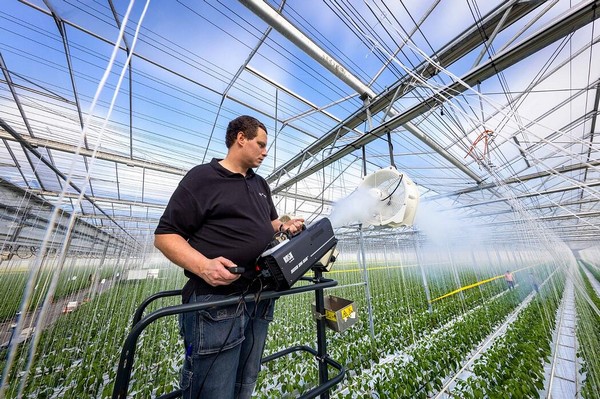In two publications, Utrecht biologists and international colleagues describe processes used by plants to adapt to warmth. The discoveries provide insights into how plants function optimally under suboptimal high temperatures. It also could provide a stepping stone towards controlling the growth of plants and making them more resistant to global warming. The researchers publish their results in The Plant Journal and Nature Communications.
Polar bears in the desert
Yet many plant species have developed ways to cope with higher temperatures. “Unlike animals, many plants can adapt their body shape in response to warmth and other environmental factors,” says researcher Martijn van Zanten, who is affiliated with Utrecht University and contributed to both publications. “Animals are a whole different story. Simply put, if you place a polar bear in the desert, it will still look like a polar bear with a thick fur coat. But if a plant grows in warmer conditions, it will adapt its body shape accordingly. In this way, the plant tries to function optimally under these less favorable conditions.”
From compact to open plant form
Many plant species can adapt the shape of their stems and leaves to make them more resistant to high temperatures. This is also true for thale cress (Arabidopsis thaliana), regarded by many plant biologists as their favorite plant model. In cold conditions, these plants are compact and have their leaves close to the ground. When temperatures rise, they take on a more open posture. Leaves, for example, become more upright. This greatly reduces the direct radiation from the sun. In addition, the leaf stalks will stretch, allowing more wind to pass the leaves and dissipate the heat.
Desired and unwanted stretching
Yet in crops and (cut) flowers, this kind of stretching is often unwanted. Growers want to control these changes since stretching can impede product quality. “But at the same time, adaptation is necessary to make crops more resistant to the higher temperatures resulting from climate change. That is needed to maintain production in the longer term,” says Van Zanten.
Making plants more climate-tolerant
“Many cultivated crops have lost the ability to respond well to higher temperatures,” says Van Zanten. “In various crops, it disappeared during the domestication and breeding process since breeders primarily focused on other traits.”
With climate change driving up temperatures, Van Zanten says there is an increasing need to make plants more climate-tolerant. “This requires knowledge of how plants cope with higher temperatures. How do they convert the temperature signals they receive into growth adaptations? Researching the molecular mechanisms by which plants adapt to suboptimal temperature, allows for tools to adjust the architecture of crops through breeding.”
Molecular mechanism switches on heat posture
Thale cress plants that no longer adapt to higher temperatures appear can regain that ability when exposed to certain chemicals. This was discovered by an international research team led by Van Zanten. The team tested a large number of substances on a thale cress mutant that no longer adapts to high temperatures. They found a molecule that can ‘switch on’ the adaptation to high temperature in young plants, even at low temperatures.
The researchers call this compound ‘Heatin’. By chemically modifying the molecule and then studying which proteins can bind to heating, they found a group of proteins called nitrilases. The identified subgroup is known to occur only in cabbages and related species, including thale cress.
Together with a plant breeding company, the biologists discovered that indeed cabbage species respond to heating. They also discovered that the nitrilases are required for adaptation to high temperature, probably because they enable the production of the well-known growth hormone auxin. The researchers published this discovery in The Plant Journal.
New pathway for high-temperature adaptation
The publication of the Heatin results coincides with another publication, today in Nature Communications. That research was led by scientists at the VIB institute in Belgium, with Van Zanten also being involved. The team discovered a previously undescribed protein that regulates the way plants adapt to a warmer environment. The protein was named MAP4K4/TOT3, with TOT meaning Target of Temperature.
Remarkably, the TOT3-driven process is largely independent of all other signaling pathways that biologists have so far linked to warmth adaptation in plants. In addition, the adaptations by TOT3 do not appear to be dependent on the amount and composition of light that shines on a plant.
Van Zanten: “There’s a great deal of overlap in the molecular mechanisms by which plants adapt growth to changing light composition and to high temperature. With TOT3, we now have a factor at hand with which we can control growth under high temperatures, without interfering with the way the plant deals with light.”
Broad applications
“What makes it even more interesting,” says Van Zanten, “is that TOT3 plays a similar role in growth adaptation under high temperature in both thale cress and in wheat. Those two species are genetically quite separated from each other. So that offers great potential for broad applications.”
Alternative to growth inhibitors
Ultimately, the discoveries of TOT3 and the role of nitrilases can help to continue growing sufficient crops, even when temperatures rise due to climate change. The discoveries also offer opportunities to develop alternatives to chemicals that are now often used to inhibit plant growth. As an example, Van Zanten mentions cut flowers, which respond very strongly to temperature fluctuations. In floriculture, therefore, many growth inhibitors are used to keep the plants nice and compact.
“The moment you buy tulips, for example, they still have a nice short stem,” says Van Zanten. “But after a few days in your home, they start hanging over the edge of the vase. The higher indoor temperatures cause the plants to stretch, eventually leading them to go limp and bend. We hope that the new knowledge will contribute to the selection of new flower varieties that stretch less under high temperatures. In this way, we can reduce the use of harmful growth inhibitors.”
For more information:
Utrecht University
www.uu.nl











